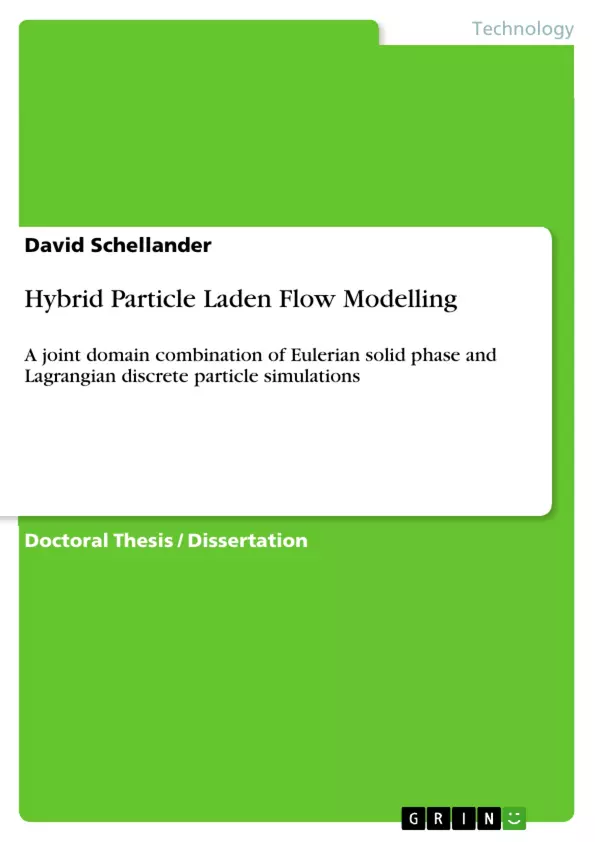
Hybrid Particle Laden Flow Modelling
Doktorarbeit / Dissertation, 2013
152 Seiten, Note: 1
Leseprobe
Table of Contents
- Abstract
- Zusammenfassung
- 1 Introduction
- 1.1 Motivation
- 1.2 Objective
- 1.3 Structure of the Thesis
- 2 Fundamentals
- 2.1 Governing Equations for Fluid Flow
- 2.2 Discrete Particle Modelling
- 2.3 Eulerian-Lagrangian Coupling
- 3 Numerical Methods
- 3.1 Finite Volume Method
- 3.2 Discrete Element Method
- 3.3 Coupling Approaches
- 4 Validation and Application
- 4.1 Validation Cases
- 4.2 Industrial Application
- 5 Conclusion
- List of Symbols
- References
Objectives and Key Themes
This dissertation focuses on developing a hybrid numerical method for modeling particle-laden flows. The main objective is to combine the advantages of Eulerian and Lagrangian approaches to achieve a more accurate and efficient simulation method. Key themes explored in the dissertation include:- Development of a hybrid particle-laden flow model
- Integration of Eulerian and Lagrangian simulation techniques
- Validation of the model against experimental data
- Application of the model to industrial problems
- Analysis of the influence of particle properties and flow conditions on the simulation results
Chapter Summaries
Chapter 1 introduces the motivation and objective of the dissertation. It provides a brief overview of particle-laden flows and the challenges associated with their simulation. The chapter also outlines the structure of the thesis. Chapter 2 reviews the fundamental equations governing fluid flow and introduces the concepts of discrete particle modeling and Eulerian-Lagrangian coupling. It discusses the advantages and disadvantages of different modeling approaches. Chapter 3 describes the numerical methods used in the dissertation. It presents details about the finite volume method for solving the fluid flow equations and the discrete element method for simulating particle motion. It also discusses various coupling approaches for integrating the two methods. Chapter 4 focuses on the validation and application of the developed hybrid model. It presents validation cases using experimental data and an industrial application of the model.
Keywords
The primary focus of this dissertation is on particle-laden flows, hybrid modeling techniques, Eulerian-Lagrangian coupling, finite volume method, discrete element method, validation, and industrial applications. The work investigates the development and application of a comprehensive model for simulating complex multiphase flows involving particles.Details
- Titel
- Hybrid Particle Laden Flow Modelling
- Untertitel
- A joint domain combination of Eulerian solid phase and Lagrangian discrete particle simulations
- Hochschule
- Johannes Kepler Universität Linz (Department on Particulate Flow Modelling)
- Note
- 1
- Autor
- David Schellander (Autor:in)
- Erscheinungsjahr
- 2013
- Seiten
- 152
- Katalognummer
- V233622
- ISBN (Buch)
- 9783656501824
- ISBN (eBook)
- 9783656501923
- Dateigröße
- 3451 KB
- Sprache
- Englisch
- Schlagworte
- Computational Fluid Dynamics CFD Particle transport Euler-Euler granular model Euler-Lagrangian discrete phase model particle separation particle ladden flow
- Produktsicherheit
- GRIN Publishing GmbH
- Preis (Ebook)
- US$ 49,99
- Preis (Book)
- US$ 59,99
- Arbeit zitieren
- David Schellander (Autor:in), 2013, Hybrid Particle Laden Flow Modelling, München, Page::Imprint:: GRINVerlagOHG, https://www.diplomarbeiten24.de/document/233622
- Autor werden
- Ihre Optionen
- Vertriebskanäle
- Premium Services
- Autorenprofil
- Textarten und Formate
- Services für Verlage, Hochschulen, Unternehmen

- © GRIN Publishing GmbH.
- Alle Inhalte urheberrechtlich geschützt. Kopieren und verbreiten untersagt.
- info@grin.com
- AGB
- Open Publishing
Der GRIN Verlag hat sich seit 1998 auf die Veröffentlichung akademischer eBooks und Bücher spezialisiert. Der GRIN Verlag steht damit als erstes Unternehmen für User Generated Quality Content. Die Verlagsseiten GRIN.com, Hausarbeiten.de und Diplomarbeiten24 bieten für Hochschullehrer, Absolventen und Studenten die ideale Plattform, wissenschaftliche Texte wie Hausarbeiten, Referate, Bachelorarbeiten, Masterarbeiten, Diplomarbeiten, Dissertationen und wissenschaftliche Aufsätze einem breiten Publikum zu präsentieren.
Kostenfreie Veröffentlichung: Hausarbeit, Bachelorarbeit, Diplomarbeit, Dissertation, Masterarbeit, Interpretation oder Referat jetzt veröffentlichen!
- GRIN Verlag GmbH
-
- Nymphenburger Str. 86
- 80636
- Munich, Deutschland
- +49 89-550559-0
- +49 89-550559-10
- info@grin.com
-









